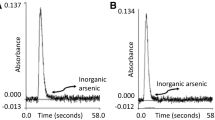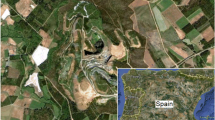Abstract
Microstructural changes induced by the microbial reduction of Fe(III) in nontronite by Shewanella oneidensis were studied using environmental cell (EC)-transmission electron microscopy (TEM), conventional TEM, and X-ray powder diffraction (XRD). Direct observations of clays by EC-TEM in their hydrated state allowed for the first time an accurate and unambiguous TEM measurement of basal layer spacings and the contraction of layer spacing caused by microbial effects, most likely those of Fe(III) reduction. Non-reduced and Fe(III)-reduced nontronite, observed by EC-TEM, exhibited fringes with mean d001 spacings of 1.50 nm (standard deviation, σ = 0.08 nm) and 1.26 nm (σ = 0.10 nm), respectively. In comparison, the same samples embedded with Nanoplast resin, sectioned by microtome, and observed using conventional TEM, displayed layer spacings of 1.0–1.1 nm (non-reduced) and 1.0 nm (reduced). The results from Nanoplast-embedded samples are typical of conventional TEM studies, which have measured nearly identical layer spacings regardless of Fe oxidation state. Following Fe(III) reduction, both EC- and conventional TEM showed an increase in the order of nontronite selected area electron diffraction patterns while the images exhibited fewer wavy fringes and fewer layer terminations. An increase in stacking order in reduced nontronite was also suggested by XRD measurements. In particular, the ratio of the valley to peak intensity (v/p) of the 1.7 nm basal 001 peak of ethylene glycolated nontronite was measured at 0.65 (non-reduced) and 0.85 (microbially reduced).
Similar content being viewed by others
References
Ahn, J.H. and Peacor, D.R. (1986) Transmission and analytical electron microscopy of the smectite-to-illite transformation. Clays and Clay Minerals, 34, 165–179.
Biscaye, P.E. (1965) Mineralogy and sedimentation of recent deep sea clay in the Atlantic Ocean and adjacent seas and oceans. Geological Society of America Bulletin, 76, 803–832.
Chen, S.Z., Low, P.F. and Roth, C.B. (1987) Relation between potassium fixation and oxidation state of octahedral iron. Soil Science Society of America Journal, 51, 82–86.
Colliex, C., Manoubi, T. and Ortiz, C. (1991) Electron-energy-loss-spectroscopy near-edge fine structures in the iron-oxygen system. Physical Review, B44, 11402–11411.
Daulton, T.L., Little, B.J., Lowe, K. and Jones-Meehan, J. (2001) In-situ environmental cell-transmission electron microscopy study of microbial reduction of chromium(VI) using electron energy loss spectroscopy. Journal of Microscopy and Microanalysis, 7, 470–485.
Drits, V.A. and Manceau, A. (2000) A model for the mechanism of Fe(III) to Fe(II) reduction in dioctahedral smectites, Clays and Clay Minerals, 48, 185–195.
Egashira, K. and Ohtsubo, M. (1983) Swelling and mineralogy of smectites in paddy soils derived from marine alluvium, Japan. Geoderma, 29, 119–127.
Foster, M.D. (1953) Geochemical studies of clay minerals: II. Relation between ionic substitution and swelling in montmorillonites. American Mineralogist, 38, 994–1006.
Fukami, A., Fukushima, K. and Kohyama, N. (1991) Observation technique for wet clay minerals using film-sealed environmental cell equipment attached to a high-resolution electron microscope. Pp. 321–331 in: Microstructure of Fine-grained Sediments from Mud to Shale (R.H Bennett, W.R. Bryant, M.H. Hulbert, editors). Springer-Verlag, New York.
Gates, W.P., Wilkinson, H.T. and Stucki, J.W. (1993) Swelling properties of microbially reduced ferruginous smectite. Clays and Clay Minerals, 41, 360–364.
Keeling, J.L., Raven, M.D. and Gates, W.P. (2000) Geology and characterization of two hydrothermal nontronites from weathered metamorphic rocks at the Uley graphite mine, South Australia. Clays and Clay Minerals, 48, 537–548.
Keller, M.D., Bellows, W.K. and Guillard, R.L. (1988) Microwave treatment for sterilization of phytoplankton culture media. Journal of Experimental Marine Biology and Ecology, 117, 279–283.
Khaled, E.M. and Stucki, J.W. (1991) Effect of iron oxidation state on cation fixation in smectites. Soil Science Society of America Journal, 55, 550–554.
Kim, J.W., Peacor, D.R., Tessier, D. and Elsass, F. (1995) A technique for maintaining texture and permanent expansion of smectite interlayers for TEM observations. Clays and Clay Minerals, 43, 51–57.
Kohyama, N., Shimoda, S. and Sudo, T. (1973) Iron-rich saponite (ferrous and ferric forms). Clays and Clay Minerals, 21, 229–237.
Kostka, J.E., Haefele, E., Viehweger, R. and Stucki, J.W. (1999) Respiration and dissolution of iron (III)-containing clay minerals by bacteria. Environmental Science and Technology, 33, 3127–3133.
Kostka, J.E., Stucki, J.W., Nealson, K.H. and Wu, J. (1996) Reduction of structural Fe(III) in smectite by a pure culture of Shewanella Putrefaciens strain MR-1. Clays and Clay Minerals, 44, 522–529.
Leapman, R.D., Gunes, L.A. and Fejes, P.L. (1982) Study of the L23 edges in the 3d transition metals and their oxides by electron-energy-loss spectroscopy with comparisons to theory. Physical Review, B 26, 614–635.
Lear, P.R. and Stucki, J.W. (1989) Effects of iron oxidation state on the specific surface area of nontronite. Clays and Clay Minerals, 37, 547–552.
Lee, J.H. and Peacor, D.R. (1986) Expansion of smectite by lauylamine hydrochloride: Ambiguities in transmission electron microscope observations. Clays and Clay Minerals, 34, 69–73.
Leppard, G.G., Heissenberger, A. and Herndl, G.J. (1996) Ultrastructure of marine snow. I. Transmission electron microscopy methodology. Marine Ecology Progress Series, 135, 289–298.
Myers, C.R. and Nealson, K.H. (1988) Bacterial manganese reduction and growth with manganese oxide as the sole electron acceptor. Science, 240, 1319–1321.
Ravina, I. and Low, P.F. (1972) Relation between swelling, water properties and b-dimension with swelling of montmorillonite. Clays and Clay Minerals, 20, 109–123.
Ravina, I. and Low, P.F. (1977) Change of b-dimension with swelling of montmorillonite. Clays and Clay Minerals, 25, 196–200.
Shen, S., Stucki, J.W. and Boast, C.W. (1992) Effects of structural iron reduction on the hydraulic conductivity of Na-smectite. Clays and Clay Minerals, 40, 381–386.
Slade, P.G., Quirk, J.P. and Norrish, K. (1991) Crystalline swelling of smectite samples in concentrated NaCl solutions in relation to layer charge. Clays and Clay Minerals, 39, 234–238.
Stucki, J.W. and Tessier, D. (1991) Effects of iron oxidation state on the texture and structural order of Na-nontronite gels. Clays and Clay Minerals, 39, 137–143.
Stucki, J.W., Low, P.F., Roth, C.B. and Golden, D.C. (1984) Effects of oxidation state of octahedral iron on clay swelling. Clays and Clay Minerals, 32, 357–362.
Stucki, J.W., Komadel, P. and Wilkinson, H.T. (1987) Microbial reduction of structural iron(III) in smectites. Soil Science Society of America Journal, 51, 1663–1665.
Tessier, D. (1984) Etude experimentale de l’organisation des materiaux argileux: Hydratation, gonflement et structuration au cours de a desiccation et de la rehumectation. Ph.D. thesis, University of Paris, France, 361 pp.
van Aken, P.A., Liebscher, B. and Styrsa, V.J., (1998) Quantitative determination of iron oxidation states in minerals using Fe L2,3-edge electron energy-loss near-edge structure spectroscopy. Physics and Chemistry of Minerals, 25, 323–327.
van Aken, P.A., Styrsa, V.J., Liebscher, B., Woodland, A.B., Redhammer, G.J. (1999) Microanalysis of Fe3+/ΣFe in oxide and silicate minerals by investigation of electron energy-loss near-edge structures (ELNES) at the Fe M2,3 edge. Physics and Chemistry of Minerals, 26, 584–590.
Wu, J., Roth, C.B. and Low, P.F. (1988) Biological reduction of structural iron in Na-nontronite. Soil Science Society of America Journal, 52, 295–296.
Wu, J., Low, P.F. and Roth, C.B. (1989) Effects of octahedral-iron reduction and swelling pressure on interlayer distances in Na-nontronite. Clays and Clay Minerals, 37, 211–218.
Author information
Authors and Affiliations
Corresponding author
Rights and permissions
About this article
Cite this article
Kim, Jw., Furukawa, Y., Daulton, T.L. et al. Characterization of Microbially Fe(III)-Reduced Nontronite: Environmental Cell-Transmission Electron Microscopy Study. Clays Clay Miner. 51, 382–389 (2003). https://doi.org/10.1346/CCMN.2003.0510403
Received:
Revised:
Published:
Issue Date:
DOI: https://doi.org/10.1346/CCMN.2003.0510403




